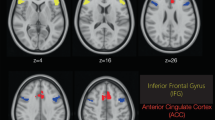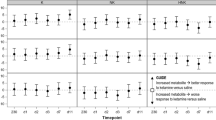Abstract
Rationale
Resting brain perfusion, measured using the MRI-based arterial spin labelling (ASL) technique, is sensitive to detect central effects of single, clinically effective, doses of pharmacological compounds. However, pharmacological interaction experiments, such as the modulation of one drug response in the presence of another, have not been widely investigated using a task-free ASL approach.
Objectives
We assessed the effects of three psychoactive compounds (ketamine, risperidone and lamotrigine), and their interaction, on resting brain perfusion in healthy human volunteers.
Methods
A multivariate Gaussian process classification (GPC) and more conventional univariate analyses were applied. The four pre-infusion conditions for each subject comprised risperidone, lamotrigine and two placebo sessions. The two placebo conditions enabled us to evaluate the classification performance in a test-retest setting, in addition to its performance in distinguishing the active oral drugs from placebo (direct effect on brain perfusion). The post ketamine- or saline-infusion scans allowed the effect of ketamine, and its interaction with risperidone and lamotrigine, on brain perfusion to be characterised.
Results
The pseudo-continuous ASL measurements of perfusion were sensitive to the effects of ketamine infusion and risperidone. The GPC captured consistent changes in perfusion across the group and contextualised the univariate changes with a larger pattern of regions contributing to accurate discrimination of ketamine from placebo.
Conclusions
The findings argue against perfusion changes confounding in the previously described evoked BOLD response to ketamine and emphasise the blockade of the NMDA receptor over neuronal glutamate release in determining the perfusion changes induced by ketamine.





Similar content being viewed by others

References
Absalom AR, Lee M, Menon DK, Sharar SR, De Smet T, Halliday J, Ogden M, Corlett P, Honey GD, Fletcher PC (2007) Predictive performance of the Domino, Hijazi, and Clements models during low-dose target-controlled ketamine infusions in healthy volunteers. Br J Anaesth 98:615–623
Clements JA, Nimmo WS (1981) Pharmacokinetics and analgesic effect of ketamine in man. Br J Anaesth 53:27–30
Cohen AF, Land GS, Breimer DD, Yuen WC, Winton C, Peck A (1987) Lamotrigine, a new anticonvulsant: pharmacokinetics in normal humans. Clin Pharmacol Ther 42(5):535–541
Dai W, Garcia DM, de Bazelaire C, Alsop DC (2008) Continuous flow-driven inversion for arterial spin labeling using pulsed radio frequency and gradient fields. Magn Reson Med 60:1488–1497
De Simoni S, Schwarz AJ, O’Daly OG, Marquand AF, Brittain C, Gonzales C, Stephenson S, Williams SCR, Mehta MA (2013) Test-retest reliability of the BOLD pharmacological MRI response to ketamine in healthy volunteers. NeuroImage 64(1):75–90
Deakin JF, Lees J, McKie S, Hallak JE, Williams SR, Dursun SM (2008) Glutamate and the neural basis of the subjective effects of ketamine: a pharmaco-magnetic resonance imaging study. Arch Gen Psychiatry 65(2):154–164
Doyle OM, Ashburner J, Zelaya FO, Williams SC, Mehta MA, Marquand AF (2013a) Multivariate decoding of brain images using ordinal regression. NeuroImage 81C:347–357
Doyle OM, De Simoni S, Schwarz AJ, Brittain C, O'Daly OG, Williams SCR, Mehta MA (2013b) Quantifying the attenuation of the ketamine phMRI response in humans: a validation using antipsychotic and glutamatergic agents. J Pharmacol Exp Ther 345(1):151–160
Duff EP, Vennart W, Wise RG, Howard MA, Harris RE, Lee M, Wartolowska K, Wanigasekera V, Wilson FJ, Whitlock M, Tracey I, Woolrich MW, Smith SM (2015) Learning to identify CNS drug action and efficacy using multistudy fMRI data. Sci Transl Med 7:274ra16
Duncan GE, Miyamoto S, Leipzig JN, Liberman JA (1999) Compaeison of brain metabolic activity patterns induced by ketamine, MK-801 and amphetamine in rats: support for NMDA receptor involvement in responses to subanesthetic dose of ketamine. Brain Res 843(1-2):171–183
Gozzi A, Large CH, Schwarz A, Bertani S, Crestan V, Bifone A (2008) Differential effects of antipsychotic and glutamatergic agents on the phMRI response to phencyclidine. Neuropsychopharmacology 37(7):1690–1703
Haufe S, Meinecke F, Gorgen K, Dahne S, Haynes JD, Blankertz B, Biesmann F (2014) On the interpretation of weight vectors of linear models in multivariate neuroimaging. NeuroImage 15:96–110
Hodkinson DJ, O’Daly O, Zunszain PA, Pariante CM, Lazurenko V, Zelaya FO, Howard MA, Williams SCR (2014) Circadian and homeostatic modulation of functional connectivity and regional cerebral blood flow in humans under normal entrained conditions. J Cereb Blood Flow Metab 34:1493–1499
Hoflich A, Hahn A, Kublbock M, Kranz GS, Vanicek T, Windischberger C, Saria A, Kasper S, Winkler D, Lanzenberger R (2015) Ketamine-induced modulation of the thalamo-cortical network in healthy volunteers as a model of schizophrenia. Int J Neuropsychopharmacol 18(9). doi:10.1093/ijnp/pyv040
Holcomb HH, Lahti AC, Medoff DR, Weiler M, Tamminga CA (2001) Sequential regional cerebral blood flow brain scans using PET with H2(15)O demonstrate ketamine actions in CNS dynamically. Neuropsychopharmacology 25:165–172
Honey G, Bullmore E (2004) Human pharmacological MRI. Trends Pharmacol Sci 25(7):366–374
Huang ML, van Peer R, Woestenborghs R, de Coster R, Heykants J, Jansen AA (1993) Pharmacokinetics of the novel antipsychotic agent risperidone and the prolactin response in healthy subjects. Clin Pharmacol Ther 54(3):257–268
Joules R, Doyle OM, Schwarz AJ, O’Daly OG, Brammer M, Williams SC, Mehta MA (2015) Ketamine induces a robust whole-brain connectivity pattern that can be differentially modulated by drugs of different mechanism and clinical profile. Psychopharmacology. doi:10.1007/s00213-015-3951-9
Khalili-Mahani NK, Niesters M, van Osch MJP, Oitzl MS, Veer IM, de Rooij M, van Gerven JMA, van Buchem MA, Beckmann CF, Rombouts SARB, Dahan A (2015) Ketamine interactions with biomarkers of stress: A randomized placebo-controlled repeated measures resting state fMRI and PCASL pilot study in healthy men. NeuroImage 108:396–409
Klöppel S, Abdulkadir A, Jack CR Jr, Koutsouleris N, Mourão-Miranda J, Vemuri P (2012) Diagnostic neuroimaging across diseases. NeuroImage 61(2):457–463
Långsjö JW, Kaisti KK, Aalto S, Hinkka S, Aantaa R, Oikonen V, Sipilä H, Kurki T, Silvanto M, Scheinin H (2003) Effects of subanesthetic doses of ketamine on regional cerebral blood flow, oxygen consumption, and blood volume in humans. Anesthesiology 99(3):614–623
Långsjö JW, Salmi E, Kaisti KK, Aalto S, Hinkka S, Aantaa R, Oikonen V, Viljanen T, Kurki T, Silvanto M, Scheinin H (2004) Effects of subanesthetic ketamine on regional cerebral glucose metabolism in humans. Anesthesiology 100(5):1065–1071
Långsjö JW, Maximow A, Salmi E, Kaisti KK, Aalto S, Oikonen V, Hinkka S, Aantaa R, Sipila H, Viljanen T, Parkkola R, Scheinin H (2005) S-ketamine anesthesia increases cerebral flow in excess of the metabolic needs in humans. Anesthesiology 103(2):258–268
Large CH, Webster EL, Goff DC (2005) The potential role of lamotrigine in schizophrenia. Psychopharmacology 181(3):415–436
Marquand A, Howard M, Brammer M, Chu C, Coen S, Mourao-Miranda J (2010) Quantitative prediction of subjective pain intensity from whole-brain fMRI data using Gaussian processes. NeuroImage 49(3):2178–2189
Marquand AF, O'Daly OG, De Simoni S, Alsop DC, Maguire RP, Williams SC, Zelaya FO, Mehta MA (2012) Dissociable effects of methylphenidate, atomoxetine and placebo on regional cerebral blood flow in healthy volunteers at rest: a multi-class pattern recognition approach. NeuroImage 60:1015–1024
Ota M, Ischikawa M, Sato N, Okazaki M, Maikusa N, Hori H, Hattori K, Teraischi T, Ito K, Kunuqi H (2014) Schizophr Res 154(1-3):113–118
Palhano-Fontes F, Andrade KC, Tofoli LF, Santos AC, Crippa JA, Hallak JE, Ribeiro S, de Araujo DB (2015) The psychedelic state induced by ayahuasca modulates the activity and connectivity of the default mode network. PLoS One 10(2), e0118143
Paloyelis Y, Doyle OM, Zelaya FO, Maltezos S, Williams SC, Fotopoulou A, Howard MA (2014) A spatiotemporal profile of in vivo cerebral blood flow changes following intranasal oxytocin in humans. Biol Psychiatry. doi:10.1016/j.biopsych.2014.10.005
Pereira F, Mitchell T, Botvinick M (2013) Machine learning classifiers and fMRI: a tutorial overview. NeuroImage 64(1):75–90
Qin P, Northoff G (2011) How is our self related to midline regions and the default-mode network? NeuroImage 57(3):1221–1233
Rasmussen CE, Williams CKI (2006) Gaussian processes for machine learning. MIT press, Cambridge
Rowland LM, Beason-Held L, Tamminga CA, Holcomb HH (2010) The interactive effects of ketamine and nicotine on human cerebral flow. Psychopharmacology 208(4):575–584
Steward CA, Marsden CA, Prior MJ, Morris PG, Shah YB (2005) Methodological considerations in rat brain BOLD contrast pharmacological MRI. Psychopharmacology 180(4):687–704
Tauscher J, Kapur S, Verhoeff NP, Hussey DF, Daskalakis ZJ, Tauscher-Wisniewski S, Wilson AA, Houle S, Kasper S, Zipursky RB (2002) Brain serotonin 5-HT(1A) receptor binding in schizophrenia measured by positron emission tomography and [11C]WAY-100635. Arch Gen Psychiatry 59(6):514–520
Vogt BA (2014) Submodalities of emotion in the context of cingulate subregions. Cortex 59:197–202
Wang DJJ, Chen Y, Fernandez-Seara MA, Detre JA (2011) Potentials and challenges for arterial spin labeling in pharmacological magnetic resonance imaging. J Pharmacol Exp Ther 337:359–366
Zelaya FO, Fernández-Seara MA, Black KJ, Williams SCR, Mehta MA (2015). Perfusion in pharmacologic imaging. In: Bammer R (ed) MR & CT perfusion imaging: clinical applications and theoretical principles, Lippincott Williams & Wilkins
Zhu J, Zhuo C, Qin W, Xu Y, Xu L, Liu X, Yu C (2015) Altered resting-state cerebral blood flow and its connectivity in schizophrenia. J Psychiatr Res 63:28–35
Acknowledgments
NEWMEDS—the work leading to these results, has received funding from the Innovative Medicines Initiative Joint Undertaking (IMI) under Grant Agreement No. 115008. We thank Dr. David Alsop for facilitating the ASL pulse sequence used in this study.
Author information
Authors and Affiliations
Corresponding author
Additional information
Mitul A Mehta and Adam J. Schwarz are joint last authors.
Electronic supplementary material
Below is the link to the electronic supplementary material.
ESM 1
(DOC 129 kb)
Rights and permissions
About this article
Cite this article
Shcherbinin, S., Doyle, O., Zelaya, F.O. et al. Modulatory effects of ketamine, risperidone and lamotrigine on resting brain perfusion in healthy human subjects. Psychopharmacology 232, 4191–4204 (2015). https://doi.org/10.1007/s00213-015-4021-z
Received:
Accepted:
Published:
Issue Date:
DOI: https://doi.org/10.1007/s00213-015-4021-z



